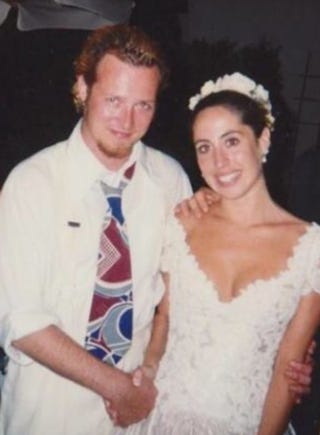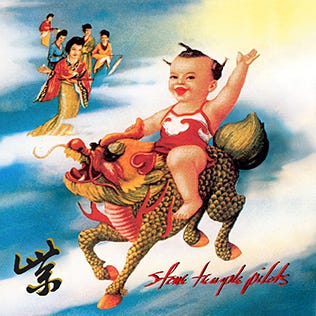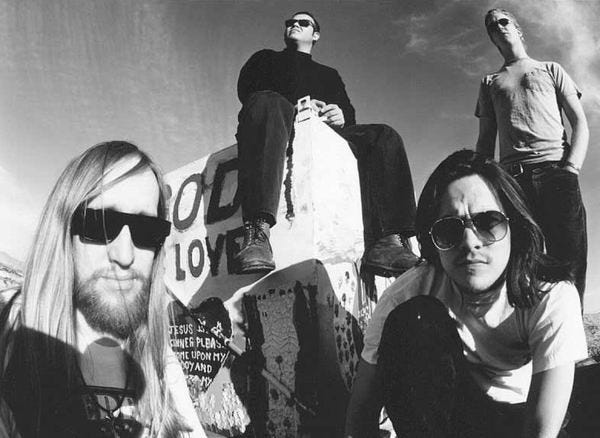On a surface level, most songs you hear are fairly straight forward in their meanings. You’ve got your classic themes: love, anger, betrayal, depression, heartbreak, and so forth. If you’ve taken a basic English class, you can figure out the general theme of the song and what emotion the artist is trying to evoke. For songs from the 1990s, you can add drugs and angst to the above mentioned list. What makes some songs truly great, though, is the artist’s ability to remain less obvious about the meaning or topic of a given song. Inspiration comes in all forms, and the genius of successful writers and musicians is to take that spark and turn it into a beautiful metaphor. Or take an exchange with a loved one and turn it into a song that conceals that meaning to the general public, but hits home for the person for whom they’ve created it.
I’ve always been interested in the true stories behind songs like these. Who was it written for? What do these lyrics really mean? More simply, who and what is the song even about? And in some cases, what are the actual lyrics to this song? Answering these questions gives songs a new depth that makes them even greater in my opinion, and adds a human element to the artists we’ve collectively idolized because of their musical abilities.
A muse, classically speaking, is a person or personified force who is the source of inspiration for a creative artist. In Greek and Roman mythology, there were nine goddesses known as muses who presided over the arts and sciences. For modern purposes, we can look at a muse as any person or thing that has inspired creative work. In this case in particular, I want to look at muses as the people, events, or actions that have led to creation of popular songs you and I have both heard over and over throughout the course of our lives.
You probably know most, if not all, of the songs on this list. I’ve chosen to cover these nine songs for two reasons. First and foremost, they are nine of my favorite songs from the ‘90s alternative rock scene. And second, you may find the who, what, and why that inspired these masterpieces to be a bit surprising.
Stone Temple Pilots – Interstate Love Song (1994)
I’ve never been one to make definitive lists for myself, but “Interstate Love Song” is in the running for my favorite song of all time. It sounded like a classic rock song from the day it came out, and might be the best song the Stone Temple Pilots ever recorded. Scott Weiland wrote the lyrics for the song while the band was on the road supporting Core, their incredible debut album that drew criticism for sounding a bit too much like Pearl Jam. Seeking to reinvent themselves, as they did on every album, their second album Purple saw Weiland incorporating more personal themes into his lyrics while the band varied their instrumentation with elements of country, classic, and acoustic sounds.
At the time he wrote the lyrics for “Interstate Love Song,” Weiland was dating a girl named Jannina Castaneda who he had met at a club in Los Angeles. He had also been introduced to the other love of his life, heroin, in August 1993 while on tour with the Butthole Surfers. While on the road, he would call Jannina to check in as the band’s tour bus rolled on through the country, but would conceal the fact that he was spiraling into heroin addiction to her.

In his 2012 memoir, Not Dead & Not for Sale, Weiland recounted his inspiration:
“Interstate Love Song” was written about the phone calls I had with Jannina. She’d ask how I was doing, and I’d lie, say I was doing fine. Chances are I had just fixed before calling her. I imagined what was going through her mind when I wrote “Waiting on a Sunday afternoon for what I read between the lines, your lies, feelin’ like a hand in rusted shame, so do you laugh or does it cry? Reply?”
The lyrics are self-reflective and self-aware and read more like a breakup song that anything else, but the two would eventually be married after the song was released in September 1994. They divorced in 2000, largely due to Scott’s drug use.
Side note: Weiland’s book contains one of my all-time favorite quotes from any musician, in regards to STP’s second album, Purple:
When the record was finished, a music writer asked me “Why did you call it Purple?”
“Because it sounds purple… that’s a stupid question.”
A second side note: The album’s cover is a re-creation of the logo on the first packet of China white heroin Weiland used while on tour. Sorry, Jannina, you never really stood a chance.

One for the road: Weiland recorded the vocals for “Interstate Love Song” in one take while the band was in studio.
Alice in Chains – Would? (1992)
In a morbid segue way, the next entry on our journey also deals largely with heroin and drug use. Layne Staley, and Alice in Chains at large, were heavy into drug use since their first album Facelift in 1990. In fact, drugs were half of the theme of their masterpiece Dirt, released in 1992. The other half of the theme? Death.
“Would?” was actually written and released on the Singles soundtrack prior to Dirt being issued. The band added it to Dirt and it became one of their biggest hits, and is one of the greatest songs released during the grunge era. The music and lyrics are written by Jerry Cantrell, but this may well be Layne’s best performance on any Alice in Chains track. One could easily assume that Cantrell is writing from his own perspective, or maybe his lead singer’s, but that’s not the case.
Though Staley is one of many tragic figures from the Seattle scene, Cantrell wrote the song as a memorial of sorts to Mother Love Bone singer Andrew Wood, who also died of a heroin overdose in 1990. Though “would” is mentioned in the last line of the song, the real meaning behind the title of the song is a play on words based on the singer’s last name.

Cantrell has explained his thought process a couple of times throughout the years since writing “Would?”:
1999: I was thinking a lot about Andrew Wood at the time. We always had a great time when we did hang out, much like Chris Cornell and I do. There was never really a serious moment or conversation, it was all fun. Andy was a hilarious guy, full of life and it was really sad to lose him. But I always hate people who judge the decisions others make. So it was also directed towards people who pass judgments.
2017: A really significant thing for all of us - was kind of a heavier foreshadowing of some things that would directly affect us and our friends - was the death of Andy Wood. That song was me thinking about him like we all did, and trying to put that down and just kind of write a little ode for him. Because he wasn't there, and everything was taking off... It was a nice thing to be able to use that song, it was very poignant I thought, because we kind of carried him with us.
Sadly, the answer to the question “If I would, could you?” was yes. Staley died in 2002 from a heroin overdose, just as Andrew Wood had 12 years earlier.
Foo Fighters – Everlong (1997)
David Letterman’s favorite song of all time also makes my list. Very clearly a love song, Dave Grohl wrote it “in about 45 minutes” while crashing on a friend’s floor back in Virginia around Christmas of 1996. At this time, he was going through a divorce with his first wife, Jennifer Youngblood. He came up with the riff for the song by playing around with “Monkey Wrench,” the Foo’s first single from their sophomore album The Colour and the Shape. As for the lyrics, Grohl describes them this way:
That song’s about a girl that I’d fallen in love with…and it was about being connected to someone so much that not only do you love them physically and spiritually, but when you sing along with them you harmonize perfectly.
The description is appropriate considering the girl he’d fallen in love with was also a famous musician. “Everlong” was written about Louise Post, the lead singer and guitarist of Veruca Salt, who had hits in the ‘90s with “Volcano Girls” and “Seether.” Grohl had struck up a relationship with her in the midst of his divorce proceedings – which culminated in him writing this classic song, before the two eventually went their own ways.

Grohl’s quote about harmonizing perfectly may have been metaphorical, but it’s also quite literal. During the recording sessions for The Colour and the Shape, Grohl called Post at 2AM and had her record backing vocals for “Everlong” over the phone while she was in a hotel room in Chicago. You may not notice it on the original track, but check out the isolated vocals and drum track below to hear the results, especially during the chorus.
And I wonder, when I sing along with you…
Soundgarden – Spoonman (1994)
The lead single from 1994’s quintessential Superunknown, “Spoonman” just might be the happiest offering Soundgarden has in their entire catalog. The history of the song begins with the movie Singles. Jeff Ament (Pearl Jam) and Chris Cornell came up with a fake demo for the band in the movie, with “Spoonman” being one of the fabricated titles. Cornell actually recorded an acoustic version of the song as its original genesis, and the band sought to record an electric version of the song when it came time to record their follow up to Badmotorfinger.
The inspiration for the song was a street performer named Artis the Spoonman. He was a known entity in Seattle and the members of the band would see him randomly throughout the city. As you might imagine, Artis’ performances heavily involved spoons - that he would hit against different parts of his body. Prior to the song being recorded, he was often used as an in between act for the big local bands at their shows while different equipment was loaded in and out.

When it came time to record the song for Superunknown, the band had Artis come into the studio to record percussion (spoons) for the track. He was paid $1,000 for performing on the song and $7,000 to appear in the music video. You can get an idea of the nature of his performances in the Seattle streets from the video below from their studio sessions.
Despite appearing to be homeless, Artis was actually fairly well put together and played up the character of the “Spoonman” for his street performing. Cornell’s lyrics, reflected that dichotomy, while also conjuring images of him as a folk and super hero:
It's more about the paradox of who [Artis] is and what people perceive him as. He's a street musician, but when he's playing on the street, he is given a value and judged completely wrong by someone else. They think he's a street person, or he's doing this because he can't hold down a regular job. They put him a few pegs down on the social ladder because of how they perceive someone who dresses differently. The lyrics express the sentiment that I much more easily identify with someone like Artis than I would watch him play.
None of my sources, however, could confirm if all of Artis’ friends are skeletons.
The Offspring – Gone Away (1997)
In some cases, the story behind a song can be so good that you let people believe it’s true, even if it’s not.
After their breakthrough album Smash, The Offspring followed up in 1996 with Ixnay on the Hombre, which succeeded on the charts on the back of three main hits. The best of these three hits was “Gone Away,” a song clearly about the loss of a loved one.
For years, the rumor had been that lead singer Dexter Holland had written the song after after his girlfriend passed away in a car accident. He would publicly decline to talk about the song and its meaning, but longtime fans and music aficionados claimed that this was the origin of the song, and given the nature of the topic, no one really tried to prove otherwise.
But as it turns out, Holland never had a girlfriend who passed away in a car accident. It is, however, based on a real life situation that occurred to him that made him reflect on what it would be like to lose a significant other. And it all happened at a Baskin Robbins.
One night, the Offspring singer and his then-wife, Kristine Luna, went to dinner in Huntington Beach and decided to stop off for ice cream afterwards. While in the store, a couple ran in and screamed that someone was following them with a gun and pleaded for someone to call the police. As this was happening, shots started ringing out. The couple had been chased by gang members by car and decided to duck into the store for safety. The gangsters followed them into the store and decided to just start opening fire.
Holland recalls his feelings in that moment:
All of a sudden it’s like “well, fuck we’re going to die, huh?” [I’m] in hiding, trying to get behind a trash can or something, and not even knowing where the bullets are coming from. And then crawling over to my wife and putting my body on top of her’s and just knowing that I’m going to get shot any second here….the idea that we came so close to death was a real life changing moment and it was right when we were recording Ixnay… in a weird way, it made me think about dying, think about grief, and you know, what if it was my wife who had been the one [to die]?
Thankfully, no one was hurt during the incident. Holland says he went on to write the song within a week’s time. While I can’t blame the band for allowing the urban legend of the song to grow, I can also understand him not wanting to divulge such a private and terrifying moment between him and his wife. The song is fantastic, so I’ll give him a pass on both. The sentiment he expressed remains the same, and no one had to die in order for him to write it – that’s a win-win.
Listen to his full comments here:
Kyuss – Demon Cleaner (1994)
Kyuss created and defined the genre of stoner rock, but they are probably most well known for being the band Josh Homme was in before he started Queens of the Stone Age. Their third full-length album, Welcome to Sky Valley, is their crowning achievement. The first single from the album was “Demon Cleaner,” which is by far their most popular and commercially successful song, as it reached 25th on the mainstream rock charts in 1994. It has also been covered live by Tool and was featured in Guitar Hero: Metallica, further solidifying the cult hero status of the band.

The song’s most notable lyrics are the call and response “yeahs” in the chorus, but the verses indicate introspection and releasing yourself from your own demons; hence, Demon Cleaner. However, upon further inspection, it may just be about proper dental hygiene:
Nobody knows that "Demon Cleaner" is about brushing your teeth. I didn't write that song; Josh wrote it, and it meant something totally different to me. But when it goes, "You get the back ones..." he's talking about brushing your teeth. – John Garcia (Kyuss’ lead singer)
I have a tooth obsession. I've had everything done to my teeth that you could have done. I used to dream about teeth all the time—I've had nightmares about them since I was a kid, like horrible night terrors. I even went the doctor about it, and that's why I hate going to sleep even to this day. I still always have nightmares. So I'd have this recurring dream where I'm getting my teeth pulled out and then I'd flash forward and I'd be in a giant mouth with these teeth bleeding everywhere. And I'd be cleaning these giant teeth while the blood was coming down and I'd be drowning in a sea of toothbrush foam and blood. So "Demon Cleaner" was this metaphor for, you know, you gotta keep yourself clean, you gotta keep yourself tight. – Josh Homme
Inspiration comes in all forms, I suppose.
Goo Goo Dolls – Name (1995)
Long before the Goo Goo Dolls skyrocketed to worldwide fame with “Iris,” they were just a punk band with a bad name from Buffalo, New York. They toiled in mediocrity for their first three albums before breaking through to the mainstream with “Name,” a ballad that was a bit of a departure from their earlier work. “Name” dominated the radio in 1995 and reached #1 on the charts, making way for the Goo Goo Dolls to become a household name in alternative rock. The song laments lost youth and childhood, but simultaneously reads like it’s about long lost love. Again, I’ve never ranked them all, but “Name” would find its way into my top ten favorite songs from the 1990s.
The video would receive significant airplay on MTV, charting on the Top 20 Countdown for weeks at a time following its release – which is ironic, because MTV had a large part in the creation of the song. Specifically, one of the VJs from the channel at the time served as lead singer Johnny Rzeznik’s muse for this beautiful, tragic song.

Not Jenny McCarthy. Not Daisy Fuentes. Nope, it was MTV VJ, Kennedy, who was 21 at the time, who is the main inspiration for “Name.” She interviewed Rzeznik somewhere between the release of Superstar Car Wash and the writing sessions for A Boy Named Goo, and the lead singer took an interest in her despite being newly married. The two went out to dinner, and Kennedy had Rzeznik back to her apartment.
According to her book The Kennedy Chronicles (2013), it went like this:
He saw on my bookshelf a book I never thought to conceal, but for someone who had read it and had thrown themselves into the healing process there was no hiding what it meant. “Wow, so you were fucked with as a kid, huh? Yeah, me too.” There was no hiding from the recesses of my sad back- story in a chapter I didn’t think defined me. I always felt like an open book; I was never one to shrink away from my experiences or problems as I knew them, and I had a habit of telling people too much. The specifics of my past abuse were right there on the shelf, and just by reading the spine he had thrown me open in a way I wasn’t ready for. He knew what it meant to have that book, and the look in his eyes was one I wasn’t used to: pity. I didn’t want him to leave, I wanted to get to know him, and now that he was controlling the tenor of our friendship I had ceded more control than I liked.
The two shared a moment confiding in each other about their poor childhoods and connected in a romantic sense, hence the lyrics to the song are confusing outside of this context. Within this context, however, they make perfect sense. The song is about their brief romance (“you can hide beside me, maybe for a while”), their shared trauma (“now we’re grown up orphans who never knew their names”), and the hopes that she turned out alright with her new found fame (“did you lose yourself somewhere out there? did you get to get a star?”).
The most notable line of the song is also directly about Kennedy - “And I won’t tell no one your name.” Her real name is Lisa Montgomery, and Rzeznik told her he wouldn’t reveal it to anyone – and then thanked her in the liner notes for the album using her government name. A tired song keeps playing on a tired radio – and I’ll tell everybody your name in the CD booklet of my new album.
Kennedy, now a conservative talk show pundit, called it “a sweet song about a boy and girl on a couch as she curled up in a ball on his lap trying to make sense of all she’d revealed.”
If these two kids couldn’t make it, who can?
Tool – Forty Six and 2 (1996)
Okay, strap in. This one’s going to take some explaining.
Tool have long been known for the depth and complexity of their music, both lyrically and composition wise (did you know they know a whole album based on the Fibonacci sequence???). The lyrical content often focuses on introspection, collective consciousness, being one with the universe, and advancing yourself through these actions.
The peak of their career, for me, is 1996’s Ænima, a brilliant and flawless album. “Forty Six and 2” was a major single from the album, despite having no discernible music video that I can find. If you listened to alternative rock radio, you could not avoid the song, and probably still can’t to this day if alternative rock radio is still a thing. The song mentions several different ideas in the lyrics which need significant explanation.

To understand the song’s lyrics and overall themes, you need to be familiar with the work of Carl Jung, a Swiss psychiatrist who theorized about how humans may unlock their true potential. In the song’s lyrics, Maynard refers repeatedly to his shadow, which is a reference to Jung’s personality theory. Here is a summary from the Toolshed FAQ, an incredible resource that I read religiously as a child:
In Carl Jung's personality theory, the ego represents the individual's sense of personal self. The sense of personal identity is purchased, however, at the expense of certain tendencies that are rejected as 'not-self'. According to Jung, these rejected traits come together as a kind of unconscious 'counter-ego' which he termed the shadow.
We may become unduly anxious or irritated when in an environment or around a person that in some way reminds us of repressed aspects of our self. If a person has rejected his or her own sex drive, for example, that person may feel irrational fear or anger around an overtly sexual individual. The shadow may appear as a person in one's dreams, usually as an individual of the same sex.
Of all the archetypes, the shadow is the most powerful and potentially the most dangerous. It represents everything about ourselves that we fear and despise.
Maynard speaks about “stepping through his shadow and coming out the other side,” meaning he is freeing himself from everything he fears and despises. We’ve gotten that far. Now, with “forty six and 2 just ahead of [him].” Well, what the hell is he talking about?

For that answer, we need to look at the teachings of a man named Drunvalo Melchizadek:
There are three totally different kinds of humans on the Earth, meaning that they perceive the One reality in three different ways, interpreted differently. The first kind of human has a chromosome composition of 42+2. They comprise a unity consciousness that does not see anything outside themselves as being separate from themselves. To them, there is only one energy - one life, one beingness that moves everywhere. Anything happening anywhere is within them, as well. They are like cells in the body. They are all connected to a single consciousness that moves through all of them. These are the aboriginals in Australia. There might be a few African tribes left like this. Then, there is our level, comprising 44+2 chromosomes. We are a disharmonic level of consciousness that is used as a steppingstone from the 42+2 level to the next level, 46+2...These two additional chromosomes change everything…the main change will be a shift to the “unity consciousness.” Every cell in your body has its own consciousness and memory. You, the higher being that occupies your body, make the millions of different consciousnesses in your body work together as one being.
In layman’s terms, if everyone sheds their fears and hatred within themselves (their shadow), it unlocks human potential to form a collective consciousness which can advance our evolution even further (46+2 is just ahead of us!) Makes perfect sense, right? Let’s move on.
Pearl Jam – Yellow Ledbetter (1992)
What better place to end than with the most confusing and indecipherable song of all time? “Yellow Ledbetter” has essentially become a meme of the unintelligibility of Pearl Jam’s lead singer Eddie Vedder. Originally released as B-side to “Jeremy,” the song gained popularity largely due to how incomprehensible it was. Fans have asked for years if the song even has lyrics, let alone a meaning. But allegedly, it has both. I repeat, allegedly. And that’s according to the man himself. Vedder revealed the meaning and motivation for the song at a concert in 2008:
It was written around the Gulf War—this was “Papa Bush,” and it’s about a guy whose brother went to fight in the Gulf War. He was kind of an alternative-looking kid, like we were with our shorts and tights and long hair, whatever we have going on… activists and artists like many of the young people in Seattle, and smart people. We’re all drug addicts. So it’s a story about his brother being killed over there, and then he gets a yellow letter in the mail. So he tries to walk this off in this little suburban neighborhood. He’s walking it off and his mind is racing and he doesn’t know what to do. He feels like he can’t take a step without falling into some deep abyss. And so he’s walking and walking and he sees a couple on a porch with an American flag. And then he waves to them like ‘my brother,’ and the people look at him like ‘you fucking scumbag,’ like ‘who are you.’ They don’t know. They don’t know the inside. They’re just judging him by his cover. So that’s what the thought was.
The song’s lyrics, which are also subject to change and debate, are allegedly:
Unsealed on a porch a letter sat
Then you said I wanna leave it again
Once I saw her on a beach of weathered sand
And on the sand I wanna leave it again, yeah
On a weekend wanna wish it all away
And they called and I said that I want what I said
And then I call out again
And the reason oughtta leave her calm, I know
I said I don’t know whether I’m the boxer or the bag
Oh yeah, can you see them
Out on the porch
Yeah but they don’t wave
I see them
‘Round the front way, yeah
And I know and I know I don’t want to stay
Make me cry
If that’s what the song is about, and those are the actual lyrics, then yeah I can see how that would make sense. But Eddie could’ve been a couple of bottles of red in at this point explaining it all to the crowd. I’ll take him at his word but you’d be lying if you said you knew any of this was actually true.

If you want to listen to the entire audio explanation, it’s linked below. Come for the meaning of "Yellow Ledbetter," stay for the 5-minute diatribe when Eddie could’ve easily played “Leash” instead.
My goal is writing this article was to share some of my favorite songs from the ‘90s and give them a deeper and more full meaning by explaining the people, events, and things that helped inspire their creation. Understanding the context of the writer’s thought process when making these classic songs adds a level of depth that endears them to me even more.
From the songs above, we see that sometimes the term “muse” takes the more classical definition. In some cases, traumatic events, folk or fallen heroes, or even created characters can be the starting point for a classic tune. Even human evolution in a convoluted, multi-layered, confusing philosophical way.
Or sometimes, it’s just your toothbrush.


